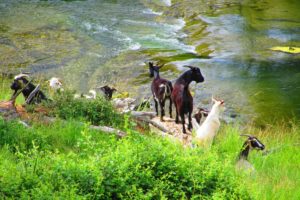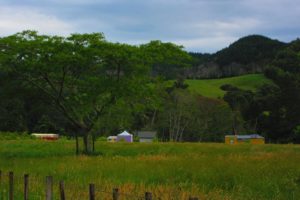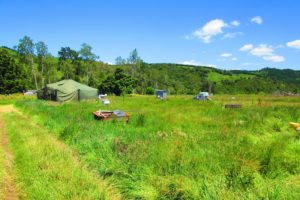‘The Tragedy (or Celebration) of the Commons’
Written by Shaked.
Not long ago, while communicating with a prospective settler, i was faced with an interesting question relating to policy and management of ‘the commons’ called ‘The Tragedy of the Commons’, here is a description of the question as presented by the thoughtful person: (thank you for that!)
[Taken from The Inverse Commons, by Eric S. Raymond, Cathedral and the Bazaar, The Inverse Commons]
“Over every attempt to explain cooperative behavior there looms the shadow of Garret Hardin’s ‘Tragedy of the Commons’. Hardin famously asks us to imagine a green held in common by a village of peasants, who graze their cattle there. But grazing degrades the commons, tearing up grass and leaving muddy patches, which re-grow their cover only slowly. If there is no agreed-on (and enforced!) policy to allocate grazing rights that prevents overgrazing, all parties incentives push them to run as many cattle as quickly as possible, trying to extract maximum value before the commons degrades into a sea of mud.
Most people have an intuitive model of cooperative behavior that goes much like this. The Tragedy of the commons actually stems from two linked problems, one of overuse and another of under provision. On the demand side, the commons situation encourages a race to the bottom by overuse – what economists call a congested-public- good problem. On the supply side, the commons rewards free-rider behavior – removing or diminishing incentives for individual actors to invest in developing more pasturage.
The tragedy of the commons predicts only three possible outcomes. One is the sea of mud. Another is for some actor with coercive power to enforce an allocation policy on behalf of the village (the communist solution). The third is for the commons to break up as village members fence off bits they can defend and manage sustainably (the property-rights solution).”
this question came in a very good timing! we have just put some efforts into developing a license for managing sheep on the village commons- and we are still in the process, as well we have a license for managing bees, and are working on putting together a sub-committee to the KVA – the Hunting and Gathering Group – these 3 examples are perfect to describe how Kotare Village intends to overcome ‘the tragedy of the commons’:
2. KVA (a democratic organisation with a committee of 5 elected for 1 year) is responsible for policy in the area that is in close proximity and within the housing clusters. this area is not designed for economic production but for the general benefit of the people living in the clusters, they have the power to set rules and bylaws regarding their land.
The ‘Hunting and Gathering Group:
Below is a list of foods, resources and pest in or near Kotare Village:
Hare, Pig – Wild, Trout, Miner – Indian, Sparrow, Magpie, Rabbit, Mouse, Pheasant, Rat, Pukeko, Possum, Turkey, Goose, Pigeon, Duck, Dear, Goat, Mallet – Sweet Water, Eal, Pine Debris – for Bio-char, Bamboo, Pine-cone, Native Bush Food, Leaf – Trees, Apple, Walnut, Plum, Blackberry, Hawthorne, Fungi, Watercress, Firewood, Kahawai, Seaweed…. and there will be more we’ve missed…
thinking about the conflict above, if each of us was doing their best hunting/ gathering as much as they could before someone else did – how would it end? (well we already know what happens all around us in the ‘open market’) so we are clear in Kotare Village that some attention is needed to be put towards this topic! in a perfect world, we all agree, we all understand, we all share the same values, and we all translate those to the same actions, which makes it very easy for us all to cooperate, but in reality we dont, we all come from different cultures…. and we are slowly creating OUR CULTURE – KOTARE CULTURE.
The Hunting and Gathering Group is designed to manage the resources above, if one wish to take part in gathering water cress or hunt dear in Kotare Village they would need to be part of the group, the group sets procedures for managing the resources (safety, mentoring, monitoring, recording, guidelines and programs).
some of the resources are off site – for example the mallet in the river are not on KCLT land, and legally there is no way to enforce the procedures set by the group, though just like the resources in the village, if those using them dont follow a program for managing them – ‘the sea of mud’ will be the result, and so we aim to create a culture that respects agreements and cooperation.
Some resources 🙂
below are drafts of 2 licenses that we have drafted during the last months, they both relate exactly to the question, in both cases the process of reaching the detail of the license was/is as follows:
1. overall discussion between villagers during ‘design night’, here we outlined the issues, and suggested different approaches for solutions.
2. individuals (or KCLT/KVA) who had specific interest in management, drew some drafts and sent them to all villagers for feedback.
3. after feedback and amendments, proposals were sent to KCLT/ KVA (as relevant) for consideration.
4. more amendments agreed upon.
5. agreement signed between the licensee and KCLT/ KVA
note that while all villagers who were/are interested have a space to communicate their thoughts, at the end, it is KCLT board/ KVA committee, that has to make the decision and sign the agreement with the person given the license…
The sea of grass!
Keeping Bees in Kotare Village – Apiary Licence
Context:
- KCLT view the management of bees in Kotare Village a matter of public interest, something that KCLT should be involved in setting policy for, this is reflected in the fact that any lease holder in Kotare Village needs a written approval from KCLT to keep bees.
- KCLT view bees as an integral part of Kotare Villages’ ability to co-evolve in our environment.
- KCLT view the health of bees in Kotare Village as a collective issue rather than managed on an individual hive or house section. It is intended the the Apiarist manages the hives for future generations in a way that allows the bees to follow their natural cycles and behaviour so that the bees are able to be in a process of coevolution with our environment.
- KCLT view the keeping of bees in Kotare Village a privilege and a service to the community, while the Apiarist might own and manage the hives and bees, it is intended that bees (and their un-separable hives) grown in Kotare Village will stay in the village, they are for the benefit of the village as a whole, this is to be taken in consideration when developing the Apiary.
- KCLT view the honey, harvested from bees in Kotare Village as a medicine to be available (as the harvest allows) to all residents of the village.
Agreement:
- The Apiarist will keep a maximum of 20 hives in Kotare Village – to be changed only after approval from KCLT.
- Once the Apiary has reached the size of 10 hives, it will never reduce the apiary size to less than that by intent.
- The apiarist will not remove from Kotare Village more than 10% of the hives during any 1 year.
- The Apiarist will own their own bees and hives, the hives will be only Warre hives.
- In a case when the apiarist wishes to cease the business they will sell the hives to someone in the village who will sign a license with KCLT.
- If the 2 parties cannot reach agreement regarding the sale value of the hives/ business, an agreed upon person or a registered valuer will determine the approved sale value.
- KCLT will not approve any other person to keep bees in Kotare Village.
- If another person wishes to keep bees in Kotare Village they will have to reach an agreement with the Apiarist. The Apiarist will provide them with a written approval for keeping the bees. This approval will replace the written approval needed from KCLT.
- The Apiarist will keep a register of all the beehives kept in Kotare Village.
- The Apiarist will be the legal authority responsible for the management of all the beehives in Kotare Village.
- The Apiarist will make available all the honey harvested through their operations in Kotare Village to residents in the village (by sharing or selling), only if there is excess honey that is not salable during a period of 3 months from harvesting. The Apiary will be eligible to sell it outside of the village.
- The Apiarist will have an ‘open door’ policy, allowing interested people from Kotare Village to join apiary management activities on real time when possible, in order to support others in the village to get familiar with our relationship with bees.
- If there is interest, the Apiary will have a simple mentorship/ apprenticeship program.
- The Apiary will make any of its records regarding the ‘state’ of the bees available to KCLT.
- The Apiary will not use any kind of insecticide, not even organic ones.
- The Apiary will pay KCLT for the ability to manage the Apiary in Kotare Village for the period it is operating – the cost of this licence.
- This licence is for ___ years and is intended to be renewed at the end of the term after review and amendments.
- Once signed, this licence is to be considered as a written approval from KCLT to keep bees in Kotare Village.
Signed:
KCLT: __________________ Apiarist:_____________________
Date: __________________ Date: _____________________
Cluster Grazing License – KCLT, KVA
Context:
- This is a temporary grazing license, designed to utilise underutilized land in Kotare Village while fulfilling the following functions:
- Keeping areas tidy.
- Increasing grass fertility.
- Reducing blackberry.
- Reducing fire risk.
- Producing sheep and goat meat and milk.
- Keeping the rare breed of black east friesians in the village.
- Making easier to sell unsold sections.
- To date there are 7.4 ha around the clusters with potential for grazing with movable electric fences:
- 2 village greens – 4,400m2 (KVA)
- Area between cluster B and Workshop – 18,360m2 (KCLT)
- Area between cluster B and pines – 5,550m2(KCLT)
- Cluster roads and paths – 5,350m2 (KVA)
- Under cluster B – 4,600m2 (KCLT)
- Under cluster A – 6,000m2 ((KCLT)
- Unsold sections – 15,000m2 (KCLT/ KC)
Agreement:
- The Grazier will use only the area allocated for grazing by KCLT and KVA as described above.
- The Grazier will use only small grazing animals: sheep and goat.
- The Grazier will prioritise grazing areas as follows:
- Keeping roads, paths and village greens tidy.
- Keeping unsold sections tidy.
- Reducing fire risk.
- Reducing blackberry.
- All other.
- This use of the grazing areas will be in exchange for the functions above.
- The Grazier will rest any area for at least 90 days.
- The Grazier will keep the animals in an electric net.
- The electric net will be made visible at night so that if in close proximity to house sections, roads or paths people will not stumble into it.
- The Grazier will be responsible for any damage to property done by the animals, including damage to trees.
- If a specific animal from the herd has escaped the electric net, KVA and KCLT will be able to demand the grazier to remove that animal from grazing under this license.
- This license is for 1 year, and both KVA and KCLT reserve the right to not continue the license or change the available areas for grazing at the end of the period.
- If, for any reason KVA or KCLT needs to use a specific area that is under grazing for a period of time in which grazing should not occur (under 90 days), a 2 day notice to the grazier will be enough, as long as there is still sufficient area to graze the animals elsewhere. (moving of animals is daily and so 2 days notice should be enough)
- If, for any reason KVA or KCLT wish to remove a specific area from being available to the grazier for more than 90 days they will give the grazier a 30 days notice (as this will change the amount of animals possible to be grazed in total by the grazier)
- KCLT and KVA will not grant any other person a license to graze areas without agreement with the Grazier.
- The Grazier will make available all the milk and meat produced through this license to residents in the village (by sharing or selling), only if there is excess produce that is not salable at the village at the time, the Grazier will be eligible to sell it outside of the village.
- The Grazier will not use any kind of non-organic fertilizers or supplements with the animals or the land used.
- This license is for the period between _________________ to ___________________
Signed:
KCLT: __________________ Grazier:_____________________
Date: __________________ Date: ______________________
KVA: __________________
Date: __________________




No comments yet.